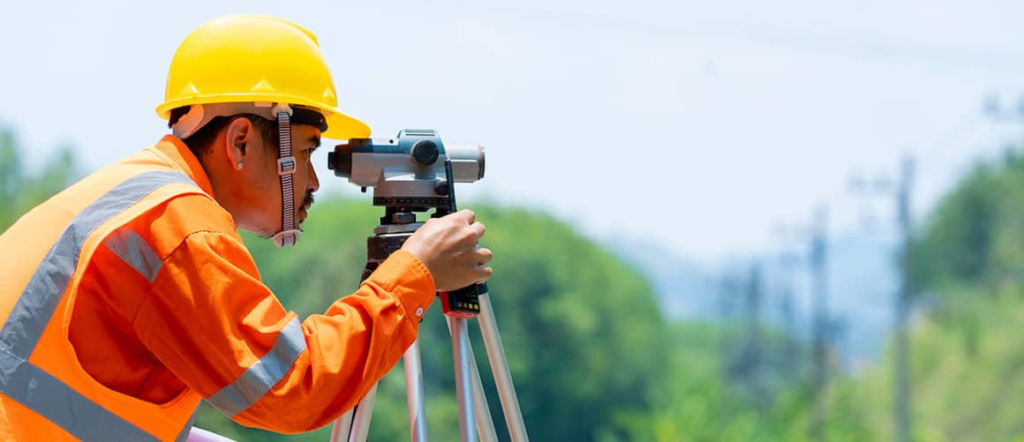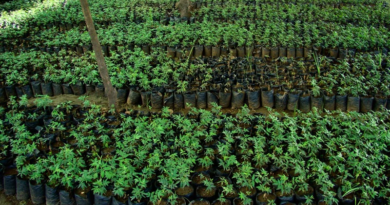Produce Mapping Surveyor 6 month course
Produce Mapping Surveyor

The Produce Mapping Surveyor manages identified goods that are produced in different supply chains and potential problems or hazards that occur in the producing regions. Brief description of the job: The Produce Mapping Examination deals with the preparation of product mapping, identifying crop residues, overseeing agricultural plant development, identifying plant pests and inadequate soil fertility, using sustainable methods and keeping product map records. Personal Qualifications: Product Map Inspector must have the ability to edit and edit. One should have decent reading and writing skills. In Produce Mapping Surveyor
Prepare for produce mapping Produce Mapping Surveyor:
In order to be effective, each user / individual must be able to: PC1. prepare crop production maps and crop production maps PC2. prepare farmers, vendors and PC3 data aggregators. update details of current production systems, land and other resources running on PC4. perform soil and water tests to detect nutrient and PC5 soil conditioning. update the product map simultaneously by informing the potential changes in the product system Identify the residue of the goods and produce In order to be competent, the user / individual must be able to: PC6. identify all products produced at a particular time and field specific PC7. view and analyze the required curve for the purchase of specific PC8 products. consider residual production if the demand for goods is very high
Organizational Context (Knowledge of the company / organization and its processes):
The user / person at work needs to know and understand: KA1. business code of conduct KA2. job responsibilities / duties KA3. KA4 product map repair procedures. work processes and policies for identifying residual assets
Technical Knowledge:
The user / person at work needs to know and understand: KB1. potential problems when preparing the map production and appropriate steps that can be taken by KB2. source of information and documentation required when planning and preparing for KB3 map production. use of modern map tools, GPS, GPRS, etc. KB4. seeking and providing asset analysis strategies Produce Mapping Surveyor
Core Skills/ Generic Skills:
The user / person at work needs to know and understand how to do this: SA1. note the details referred to SA2. note the look (if any) related to map production Learning Skills The user / employee needs to know and understand how to do this: SA3. read and interpret the SA4 mapping process. read internal information documents sent to internal groups Oral Communication (Listening and Speaking Skills) The user / person at work needs to know and understand how to do this: SA5. discuss job lists, schedules and activities SA6. contacting SA7 team members. question to understand the nature of the problem and to clarify questions B. Practicing Professional Skills To make the user / person at work need to know and understand: SB1. analyze critical points in everyday activities by experience and observation and find ways to control problem solving Planning and planning The user / person at work needs to know and understand: SB2. edit and edit the work you received SB3. plan and prioritize work based on instructions received by SB4. plans to use time and equipment efficiently Customary Centricity The user / employee needs to know and understand: SB5. understand customer needs and priorities and respond to their needs SB6. discover and share information from farmer / trader groups Troubleshooting User / employee needs to know and understand: SB7. support in problem solving by defining SB8 problems. discuss possible troubleshooting solutions Analytical Thinking The user / employee needs to know and understand: SB9. use domain information about map production preparation


Supervise agricultural crop establishment Produce Mapping Surveyor:
In order to be effective, each user / individual must be able to: PC1. identify the target location, or paddock, of the plant from the PC2 production / management system. inspect and monitor litter levels and sowing bed conditions for PC3 configuration. identify agricultural crops and planting methods to be used in the production / management system of organizations and PC4 availability. explore the necessary resources for planting activities in the area to be planted, the planting method to be used, and the available PC5 times. set target planting dates, planting sequences in all stalls or plant areas, in accordance with the design / management plan of the PC6 organization. select and configure the required chemical applications before and after planting PC7. prepare a plan to ensure that any potentially harmful environmental impacts are minimized or eliminated, including proper disposal of containers, drums and other PC8 waste. identify, risk assessments and set safe PC9 activities. determine measurable indicators, specifications and objectives based on the production / management plan and method, resources, and seeds to be used Determine the planting schedule and key commitments for PC10. determine the planting schedule taking into account a range of geographical features and resources, as well as activities that will take place simultaneously with PC11 planting. find the key responsibilities of specific preparation procedures required before planting PC12. identify key responsibilities for specific PC13 implementation processes. write down the plan, including planning and key activities Produce Mapping Surveyor
Organizational Context (Knowledge of the company / organization and its processes):
The user / person at work needs to know and understand: KA1. business code of conduct KA2. job responsibilities / duties KA3. guidelines for overseeing the development of KA4 agricultural crops. sound management and environmental impact measures such as noise, soil degradation, and waste from planting activities
Technical Knowledge:
The user / person at work needs to know and understand: KB1. agricultural practices / production strategies are followed in the area of KB2. harvesting strategies KB3. history of possible corruption of KB4. integrated pest and weed control strategies
Core Skills/ Generic Skills:
The user / person at work needs to know and understand how to do this: SA1. note the details referred to SA2. write down what you have seen (if any) related to the process Learning Skills The user / employee needs to know and understand how to do this: SA3. read and interpret the SA4 process. read internal information documents sent to internal groups Oral Communication (Listening and Speaking Skills) The user / person at work needs to know and understand how to do this: SA5. discuss job lists, schedules and activities SA6. contacting SA7 team members. question to understand the nature of the problem and to clarify questions B. Making a Professional Skills Decision The user / employee needs to know and understand: SB1. analyze critical points in day-to-day activities with experience and observation and identify ways to control problem solving
Plan and Organize The user / person at work needs to know and understand how to do it: SB2. planning and scheduling work and activities have been identified by SB3. plan and focus on work based on the instructions received by SB4. plans to use time and equipment Customer Level The user / person at work needs to know and understand that: SB5. understand customer needs and priorities and respond to their needs SB6. discover and share information from farmer / trader groups Troubleshooting User / employee needs to know and understand: SB7. support in problem solving by defining SB8 problems. discuss possible troubleshooting solutions Analytical Thinking The user / employee needs to know and understand: SB9. use background information about the mapping landscape workmanship Critical Thinking The user / person on the job needs to know and understand that: SB10. use common sense and make daily judgments SB11. use critical thinking skills to identify and solve basic problems Produce Mapping Surveyor

Identify plant pests, diseases and soil fertility issues Produce Mapping Surveyor:
In order to be effective, that person must be able to: PC1. identify plant pests, diseases and disturbances such as soil sufficiency by examining the environment and soil PC2. record and report PC3 data on crop management, diseases and inadequate soil. select treatment options in consultation with PC4 administrators. contact farmers for information collected to treat diseases and disorders
Organizational Context (Knowledge of the company / organization and its processes):
The user / person at work needs to know and understand: KA1. business code of conduct KA2. job responsibilities / duties KA3. Procedures and work requirements for the identification of plant pests, diseases and inadequate soil fertility
Technical Knowledge:
The user / person at work needs to know and understand: KB1. recognition of common plant pests, diseases and pathogens KB2. different types of control methods and their targets KB3. the different chemical reactions of KB4. legislation relating to the use of chemicals in plant pests, diseases and disease control
Core Skills/ Generic Skills:
The user / person at work needs to know and understand how to do this: SA1. note the details referred to SA2. write down what you have seen (if any) related to the process Learning Skills The user / employee needs to know and understand how to do this: SA3. read and interpret the SA4 process. read internal information documents sent to internal groups Oral Communication (Listening and Speaking Skills) The user / person at work needs to know and understand how to do this: SA5. discuss job lists, schedules and activities SA6. contacting SA7 team members. question to understand the nature of the problem and to clarify questions B. Making a Professional Skills Decision The user / employee needs to know and understand: SB1. analyze critical points in everyday activities by experience and observation and find ways to control problem solving Planning and planning The user / person at work needs to know and understand: SB2. planning and scheduling work and activities have been identified by SB3. plan and focus on work based on the instructions received by SB4. planning to use time and equipment Customer Centricity The user / employee needs to know and understand: SB5. understand customer needs and priorities and respond to their needs SB6. discover and share information from farmer / trader groups Troubleshooting User / employee needs to know and understand: SB7. support in problem solving by defining SB8 problems. discuss possible troubleshooting solutions Analytical Thinking The user / employee needs to know and understand: SB9. use background information about the mapping landscape workmanship Critical Thinking The user / person on the job needs to know and understand that: SB10. use common sense and make daily judgments SB11. use critical thinking skills to identify and solve basic problems
Implement sustainable practices in the organic farm based business Produce Mapping Surveyor:
In order to be effective, each user / individual must be able to: PC1. PC3 principles. identify the impact of best practices and principles on day-to-day farm operations and PC4 management. identify key PC5 agricultural enterprise sustainability strategies. communication and sustainability strategies for stakeholders and staff eligible for PC10. view participants’ compliance with environmental sustainability strategies throughout PC11 procurement. identify and document plans for further PC12 upgrades. encourage and assist participants to improve the system Produce Mapping Surveyor
Organizational Context (Knowledge of the company / organization and its processes):
The user / person at work needs to know and understand: KA1. business code of conduct KA2. job responsibilities / duties KA3. procedures and organizational guidelines for conducting continuous business practices on a farm-based business
Technical Knowledge:
The user / person at work needs to know and understand: KB1. Workplace agreements and practices for sustainable business practices based on the KB2 farm. policies and procedures associated with the natural cultivation of KB3. sustainability issues including environmental and social issues related to the KB4 natural farm. external measurements used in the organic farming business, including methods to improve the strategies used and the expected results


Core Skills/ Generic Skills:
The user / person at work needs to know and understand how to do this: SA1. note the details referred to SA2. write references (if any) related to the SA3 process. write information documents for internal departments / internal groups Learning Skills The user / employee needs to know and understand how to do this: SA4. read and interpret the required procedure SA5. read internal information documents sent to internal groups Oral Communication (Listening and Speaking Skills) The user / person at work needs to know and understand how to do this: SA6. discuss job lists, schedules and activities SA7. contacting SA8 team members. question to understand the nature of the problem and to clarify the questions SA9. listen to and understand the information provided by the SA10 speaker. liaising with departmental teams on the problems they face during the process B. Performing Skills Skills The user / employee needs to know and understand how to do this: SB1. analyze critical points in everyday activities by experience and observation and find ways to control problem solving Planning and planning The user / person at work needs to know and understand: SB2. planning and scheduling work and activities have been identified by SB3. edit and focus on the SB4 function. plans to use SB5 for time and equipment. to support managers in organizing assistant activities
Customer Location The user / person at work needs to know and understand how to do this: SB6. understand customer needs and priorities and respond to their needs. Problem Solving The user / employee needs to know and understand: SB7. support in problem solving by defining SB8 problems. discuss possible troubleshooting solutions Analytical Thinking The user / employee needs to know and understand: SB9. use domain information about the use of continuous practices in a farm-based business with critical thinking The user / employee needs to know and understand: SB10. use common sense and make daily judgments SB11. use critical thinking skills to identify and solve basic problems Produce Mapping Surveyor
Complete documentation and record keeping related to commodity management Produce Mapping Surveyor:
In order to be effective, each user / individual must be able to: PC1. record and maintain a detailed record of the steps and procedures used in the PC2 analysis. write and keep a record of observations (if any) related to PC3 analysis methods. write and maintain records of management strategies followed by Text and keep records of best practices and patterns In order to be competent, the user / individual must be able to: PC4. write and maintain a detailed record of trends, patterns, and other findings after PC5 analysis. record and maintain records (if any) related to assets that affect asset management Text and keep records of tools used for data collection and generated reports In order to be competent, user / individual must be able to: PC6. write and maintain a detailed record of software and other tools used for analysis, if available PC7. write and keep a record of observations (if any) related to PC8 reports. record and maintain records of primary and secondary data collection sources Produce Mapping Surveyor
Guidelines for Assessment:
- Criteria for assessment for each Qualification Pack will be created by the Sector Skill Council. Each Performance Criteria Produce Mapping Surveyor
(PC) will be assigned marks proportional to its importance in NOS. SSC will also lay down proportion of marks for Theory and
Skills Practical for each PC - The assessment for the theory part will be based on knowledge bank of questions created by the SSC.
- Assessment will be conducted for all compulsory NOS, as well as the selected elective NOS/set of NOS.
OR - Assessment will be conducted for all compulsory NOS, as well as the selected optional NOS/set of NOS.
- Individual assessment agencies will create unique question papers for theory part for each candidate at each Produce Mapping Surveyor
examination/training center (as per assessment criteria below) - Individual assessment agencies will create unique evaluations for skill practical for every student at each
examination/training center based on this criteria - To pass the Qualification Pack , every trainee should score a minimum of 70% of aggregate marks to successfully clear the Produce Mapping Surveyor
assessment. - In case of unsuccessful completion, the trainee may seek reassessment on the Qualification Pack.







